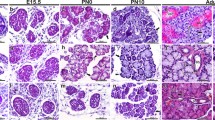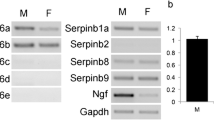Summary
The localization of 5′-nucleotidase in rat parotid and submandibular glands was investigated at the electron microscope level by an immunohistochemical technique using a highly specific antibody, and the results were compared with those obtained using the newley developed cerium method for enzyme histochemistry. Both methods demonstrated that 5′-nucleotidase is located on the external surface of the luminal plasma membranes of acinar cells as well as on intercalated and striated ductal cells. In the basolateral membranes of these cells, the portions adjacent to myoepithelial cells exhibited intense reaction products, but the other areas of plasma membranes contained only trace amounts of the reaction products. Both cerium-based enzyme histochemistry and immunohistochemistry showed that myoepithelial cells retain the enzyme on their plasma membranes. Neither method produced reaction products in the intracytoplasmic structure of constitutive cells of the salivary glands. We discuss the usefulness of the cerium-ion method for the demonstration of 5′-nucleotidase activity and compare it with the traditional lead-ion method.
Similar content being viewed by others
References
Angermüller S, Fahimi H (1984) A new cerium-based method for cytochemical localization of thiamine pyrophosphatase in the Golgi complex of rat hepatocytes. Comparison with the lead technique. Histochemistry 80:107–111
Blok J, Onderwater JJM, DeWater R, Ginsel LA (1982) A cytochemical method for the demonstration of 5′-nucleotidase in mouse peritoneal macrophages, with cerium ions used as trapping agent. Histochemistry 75:437–443
Bodansky O, Schwartz MK (1968) 5′-Nucleotidase. In: Bodansky O, Stewart CP (eds) Advance in clinical chemistry, vol II. Academic Press, New York, pp 277–328
Bogart BI (1968) The fine structural localization of alkaline phosphatase and acid phosphatase activity in the rat submandibular gland. J Histochem Cytochem 16:572–581
Borgers M (1973) The cytochemical application of new potent inhibitors of alkaline phosphatases. J Histochem Cytochem 21:812–824
Burger RM, Lowenstein JM (1970) Preparation and properties of 5′-nucleotidase from smooth muscle of small intestine. J Biol Chem 245:6274–6280
Farquhar MG, Bergeron JJM, Palade GE (1974) Cytochemistry of Golgi fractions prepared from rat liver. J Cell Biol 60:8–25
Garrett JR, Parsons PA (1973) Alkaline phosphatase and myoepithelial cells in the parotid gland of the rat. Histochem J 5:463–471
Klaushofer K, Von Mayersbach H (1979) Freeze substituted tissue in 5′-nucleotidase histochemistry. Comparative histochemical and biochemical investigations. J Histochem Cytochem 27:1582–1587
Matsuura S, Eto S, Kato K, Tashiro Y (1984) Ferritin immunoelectron microscopic localization of 5′-nucleotidase on rat liver cell surface. J Cell Biol 99:166–173
Reid E (1967) Membrane system. In: Roodyn DB (ed) Enzyme cytology. Academic Press, London, pp 321–406
Robinson JM, karnovsky MJ (1983a) Ultrastructural localization of 5′-nucleotidase in guinea pig neutrophils based upon the use of cerium as capturing agent. J Histochem Cytochem 31:1190–1196
Robinson JM, Karnovsky MJ (1983b) Ultrastructural localization of several phosphatases with cerium. J Histochem Cytochem 31:1197–1208
Rodan GA, Bouret LA, Cutler LS (1977) Membrane changes during cartilage maturation. Increase in 5′-nucleotidase and decrease in adenosine inhibition of adenylate cyclase. J Cell Biol 72:493–501
Segawa A, Sahara N, Suzuki K, Yamashina S (1985) Acinar structure and membrane regionalization as a prerequisite for exocrine secretion in the rat submandibular gland. J Cell Sci 78:67–85
Sternberger LA, Hardy PH, Cuculis JJ, Meyer HG (1970) The unlabeled antibody enzyme method of immunochemistry. Preparation and properties of soluble antigan-antibody complex (horscradish peroxidase-anti horseradish peroxidase) and its use in identification of spirochates. j Histochem Cytochem 18:315–333
Uusitalo RJ, Karnovsky MJ (1977) Surface localization of 5′-nucleotidase on the mouse lymphocytes. J Histochem Cytochem 25:87–96
Wachstein M, Meisel E (1957) Histochemistry of bepatic phosphatases at a physiological pH. Am J Clin Pathol 27:13–23
Widnell CC (1972) Cytochemical localization of 5′-nucleotidase in subcellular fractions isolated from rat liver. I. Origin of 5′-nucleotidase activity in microsomes. J Cell Biol 52:542–558
Yamashina S, Kawai K (1979) Cytochemical studies on the localization of 5′-nucleotidase in the acinar cells of the rat salivary glands. Histochemistry 60:255–263
Author information
Authors and Affiliations
Rights and permissions
About this article
Cite this article
Yamashina, S., Katsumata, O., Wada, I. et al. Electron microscopic localization of 5′-nucleotidase in rat salivary glands. Histochemistry 84, 231–236 (1986). https://doi.org/10.1007/BF00495787
Received:
Accepted:
Issue Date:
DOI: https://doi.org/10.1007/BF00495787




